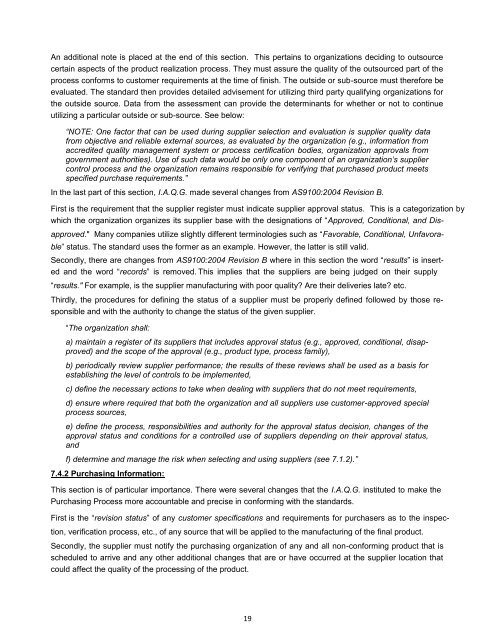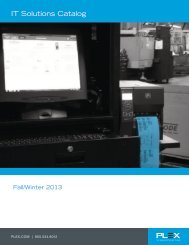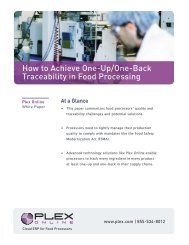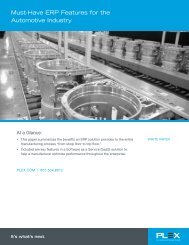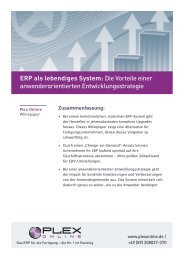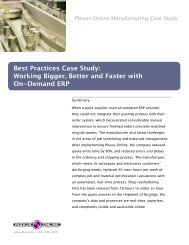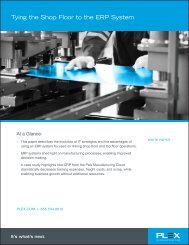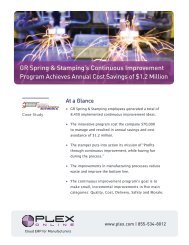How to Comply with Rev. C. - Plex Systems
How to Comply with Rev. C. - Plex Systems
How to Comply with Rev. C. - Plex Systems
You also want an ePaper? Increase the reach of your titles
YUMPU automatically turns print PDFs into web optimized ePapers that Google loves.
An additional note is placed at the end of this section. This pertains <strong>to</strong> organizations deciding <strong>to</strong> outsource<br />
certain aspects of the product realization process. They must assure the quality of the outsourced part of the<br />
process conforms <strong>to</strong> cus<strong>to</strong>mer requirements at the time of finish. The outside or sub-source must therefore be<br />
evaluated. The standard then provides detailed advisement for utilizing third party qualifying organizations for<br />
the outside source. Data from the assessment can provide the determinants for whether or not <strong>to</strong> continue<br />
utilizing a particular outside or sub-source. See below:<br />
“NOTE: One fac<strong>to</strong>r that can be used during supplier selection and evaluation is supplier quality data<br />
from objective and reliable external sources, as evaluated by the organization (e.g., information from<br />
accredited quality management system or process certification bodies, organization approvals from<br />
government authorities). Use of such data would be only one component of an organization’s supplier<br />
control process and the organization remains responsible for verifying that purchased product meets<br />
specified purchase requirements.”<br />
In the last part of this section, I.A.Q.G. made several changes from AS9100:2004 <strong>Rev</strong>ision B.<br />
First is the requirement that the supplier register must indicate supplier approval status. This is a categorization by<br />
which the organization organizes its supplier base <strong>with</strong> the designations of “Approved, Conditional, and Disapproved."<br />
Many companies utilize slightly different terminologies such as “Favorable, Conditional, Unfavorable”<br />
status. The standard uses the former as an example. <strong>How</strong>ever, the latter is still valid.<br />
Secondly, there are changes from AS9100:2004 <strong>Rev</strong>ision B where in this section the word “results” is inserted<br />
and the word “records” is removed. This implies that the suppliers are being judged on their supply<br />
“results." For example, is the supplier manufacturing <strong>with</strong> poor quality? Are their deliveries late? etc.<br />
Thirdly, the procedures for defining the status of a supplier must be properly defined followed by those responsible<br />
and <strong>with</strong> the authority <strong>to</strong> change the status of the given supplier.<br />
“The organization shall:<br />
a) maintain a register of its suppliers that includes approval status (e.g., approved, conditional, disapproved)<br />
and the scope of the approval (e.g., product type, process family),<br />
b) periodically review supplier performance; the results of these reviews shall be used as a basis for<br />
establishing the level of controls <strong>to</strong> be implemented,<br />
c) define the necessary actions <strong>to</strong> take when dealing <strong>with</strong> suppliers that do not meet requirements,<br />
d) ensure where required that both the organization and all suppliers use cus<strong>to</strong>mer-approved special<br />
process sources,<br />
e) define the process, responsibilities and authority for the approval status decision, changes of the<br />
approval status and conditions for a controlled use of suppliers depending on their approval status,<br />
and<br />
f) determine and manage the risk when selecting and using suppliers (see 7.1.2).”<br />
7.4.2 Purchasing Information:<br />
This section is of particular importance. There were several changes that the I.A.Q.G. instituted <strong>to</strong> make the<br />
Purchasing Process more accountable and precise in conforming <strong>with</strong> the standards.<br />
First is the “revision status” of any cus<strong>to</strong>mer specifications and requirements for purchasers as <strong>to</strong> the inspection,<br />
verification process, etc., of any source that will be applied <strong>to</strong> the manufacturing of the final product.<br />
Secondly, the supplier must notify the purchasing organization of any and all non-conforming product that is<br />
scheduled <strong>to</strong> arrive and any other additional changes that are or have occurred at the supplier location that<br />
could affect the quality of the processing of the product.<br />
19


